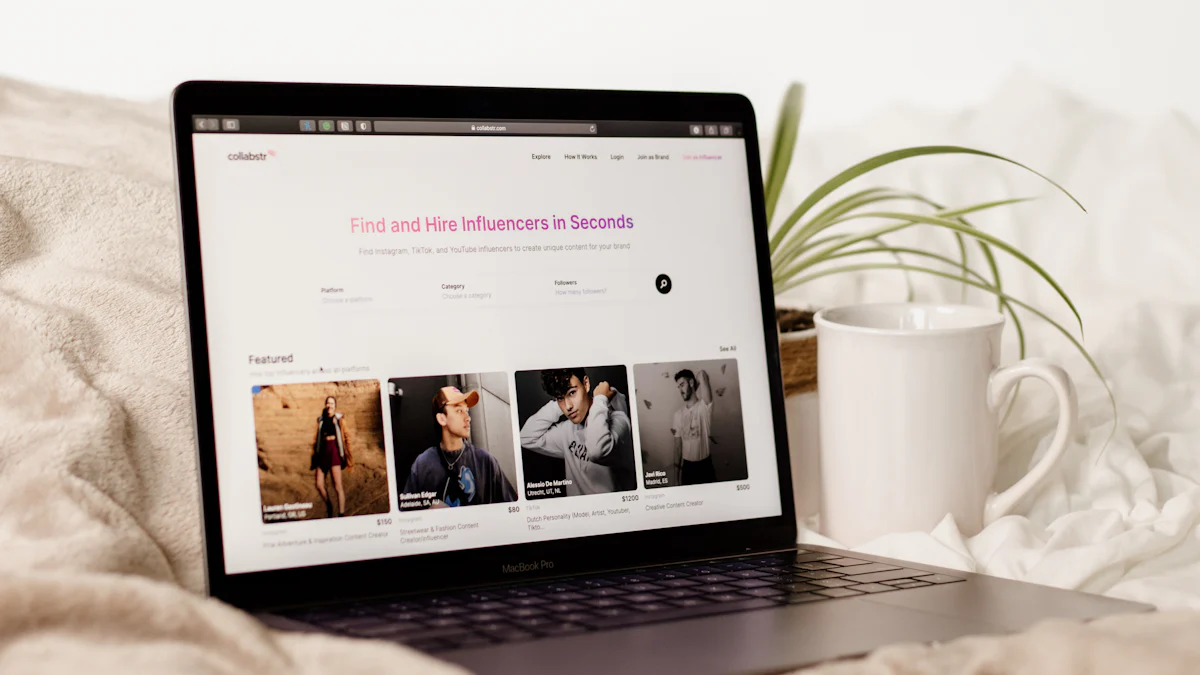Emerging Influencer Marketing Career Trends You Need to Know in 2025

The influencer marketing career field is booming like never before. It’s grown from a $1.7 billion industry in 2016 to a staggering $21.1 billion in 2023. By 2025, brands are expected to spend $9.29 billion on influencer marketing. This rapid growth means more opportunities for you to carve out a successful career.
But it’s not just about the numbers. The rise of micro and nano-influencers is reshaping the game. These smaller creators connect with audiences on a deeper level, offering trust and authenticity. At the same time, the ever-changing social media landscape keeps you on your toes, pushing you to adapt to new platforms and trends.
If you’re ready to dive into this dynamic world, 2025 could be your year to shine.
Key Influencer Marketing Career Trends in 2025

The Role of AI and Automation
AI-driven content creation and campaign management
AI is revolutionizing influencer marketing, and by 2025, its impact will be even greater. You’ll see AI-generated influencers and content becoming mainstream. Brands are already using AI to create virtual brand ambassadors who can interact with audiences 24/7. These virtual personalities are efficient, scalable, and always on-brand.
AI also makes campaign management easier. It helps you discover influencers, personalize campaigns, and measure success more accurately. Imagine having tools that optimize your campaigns in real-time or suggest the perfect influencer for your brand. AI-powered content creation and enhanced collaborations will become essential for staying competitive.
Predictive analytics for influencer selection and performance tracking
Predictive analytics tools are game-changers for influencer selection and performance tracking. Platforms like HypeAuditor and NeoReach help you find influencers while spotting fake followers. Tools like Tagger and Influencity make campaign management and ROI tracking a breeze. By 2025, you’ll rely on these tools to predict campaign outcomes and make data-driven decisions with confidence.
Platform-Specific Job Trends
Growth of niche platforms like BeReal and Threads
Niche platforms are gaining traction fast. BeReal and Threads, for example, offer less crowded spaces where you can connect with specific audiences. These platforms let you run highly targeted campaigns that feel personal and authentic. Twitch and Discord are also growing, giving you more ways to engage with unique communities.
Continued dominance of TikTok and Instagram for short-form content
TikTok and Instagram remain powerhouses for short-form content. TikTok users spend an average of 58 minutes daily on the app, while Instagram Reels boasts a 49% engagement rate. Short-form video content dominates, with TikTok accounting for 55% of time spent on such content and Instagram at 37%. If you’re focusing on short-form content, these platforms are still your best bet in 2025.
Long-Term Brand Partnerships
Benefits of sustained collaborations for influencers and brands
Long-term partnerships are a win-win. They let you build trust and authenticity with your audience while ensuring consistent brand messaging. These collaborations save time and money by reducing the need for constant negotiations. Plus, they provide valuable insights into what your audience loves, helping you refine your strategy and boost ROI.
| Benefit | Description |
|---|---|
| Authenticity and trust-building | Long-term partnerships allow influencers to naturally integrate your brand, building trust over time. |
| Consistency in brand messaging | Regular collaboration ensures consistent messaging, enhancing brand recognition and engagement. |
| Cost-efficiency over time | Reduces the need for frequent searches and negotiations, leading to a higher ROI. |
| Better performance prediction | Extended collaborations provide insights into audience preferences for informed decisions. |
| Time-efficiency | Streamlines content creation, reducing onboarding time and allowing focus on strategy refinement. |
| Marketing insights and ROI | Influencers offer valuable feedback that optimizes future campaigns and increases ROI. |
Building trust and authenticity with audiences
Sustained collaborations foster genuine connections. When you work with a brand over time, your audience sees the partnership as authentic. This transparency builds trust and makes your content more relatable. Authentic collaborations create emotional connections, making your audience more likely to engage with your content and trust your recommendations.
The Rise of Social Commerce
Integration of e-commerce features on social platforms
Social platforms are no longer just for scrolling and liking posts. By 2025, they’ll double as your favorite shopping destinations. Platforms like Instagram, TikTok, and Pinterest are leading the charge by integrating seamless e-commerce features. For instance, Instagram Shopping lets you browse and buy products directly from posts. TikTok Shopping takes it a step further with shoppable live streams, making the buying process interactive and fun.
Pinterest’s Buyable Pins and Shop tab are perfect for visually-driven industries like fashion and home decor. Facebook Shops and Marketplace offer tools for direct selling, while Snapchat’s Snap Store creates immersive shopping experiences. These features make it easier than ever for influencers to showcase products and drive sales.
What’s the big deal? Social commerce boosts brand visibility by placing products right in front of potential buyers. It also enhances customer experience by making shopping frictionless. You can explore, click, and purchase—all without leaving the app.
Influencers as key drivers of purchase decisions
You’ve probably bought something because an influencer recommended it, right? That’s the power of influencer marketing in social commerce. Influencers know how to connect with their audiences and build trust. By 2025, they’ll play an even bigger role in driving purchase decisions.
Short-form video content, like TikTok clips or Instagram Reels, is a game-changer. Influencers use these formats to create engaging product demos, tutorials, and reviews. Their authentic approach makes you feel like you’re getting advice from a friend. This trust translates into higher engagement and conversion rates for brands.
Social commerce thrives on this connection. Influencers don’t just promote products—they create stories around them. These stories resonate with audiences, making them more likely to hit that “Buy Now” button.
Essential Skills and Tools for Influencer Marketing Careers in 2025

Data-Driven Decision-Making
Understanding analytics tools and metrics
To thrive in influencer marketing, you need to master analytics tools. These tools help you understand what works and what doesn’t. Platforms like Socialinsider and Later simplify your workflow by analyzing content pillars and streamlining influencer programs. Tools like Social Blade and HypeAuditor ensure you’re working with authentic influencers by detecting fake followers. Want to track hashtag campaigns or audience demographics? Keyhole and Traackr have you covered.
Metrics like engagement rate, reach, and conversion rate are your best friends. Engagement rate shows how actively audiences interact with content. Reach tells you how many unique users see your posts, while conversion rate measures how well your campaigns drive actions. By using these tools and metrics, you can make smarter decisions and optimize campaigns for better results.
Leveraging data to optimize campaigns
Data isn’t just numbers—it’s your secret weapon. Start by selecting influencers whose audience matches your target demographic. Then, craft content that resonates with their followers. Monitor performance metrics like reach and engagement to see what’s working. Tools like Upfluence and Aspire help you track campaigns and adjust strategies in real time. With data, you can refine your approach and maximize ROI.
Creativity and Content Innovation
Staying ahead of content trends
In 2025, staying relevant means staying creative. Storytelling is a powerful way to connect with audiences. Use influencers to share authentic stories about your brand. Leverage new social media features like Instagram Reels or TikTok challenges to keep your content fresh. Interactive campaigns that encourage user participation are also a hit. Think cross-platform—diversify your campaigns to reach different audience segments.
Experimenting with new formats and storytelling techniques
Don’t be afraid to try new things. Experiment with video styles, interactive elements, and narrative structures. Innovate with visual aesthetics to make your content stand out. Influencers who adopt emerging trends and push creative boundaries will stay ahead of the curve. Whether it’s a new video format or a unique storytelling angle, creativity keeps your audience engaged.
Adaptability and Lifelong Learning
Keeping up with platform updates and algorithm changes
Social platforms evolve constantly. To stay ahead, focus on engagement. Create content that encourages likes, shares, and comments. Stick to a consistent posting schedule while maintaining quality. Use platform-specific features like Instagram Stories or TikTok’s “For You” page to boost visibility. Authentic content that resonates with audiences will always perform well.
Embracing new technologies and tools
AI tools are transforming influencer marketing. They automate influencer selection, predict campaign success, and optimize strategies in real time. Tools like Affable and Upfluence streamline outreach and tracking, saving you time and effort. Automated growth tools also help you build your online presence faster. By embracing these technologies, you’ll stay competitive in this fast-paced industry.
Mastery of Influencer Marketing Tools
Popular platforms like CreatorIQ and Aspire
If you want to excel in influencer marketing, mastering tools like CreatorIQ and Aspire is a must. These platforms simplify the entire process, from finding influencers to managing campaigns. CreatorIQ, for instance, offers advanced filtering options to help you discover influencers who align perfectly with your brand goals. Aspire, on the other hand, focuses on building strong collaborations by providing data that ensures your campaigns hit the mark.
These tools don’t just stop at influencer discovery. They also verify influencer authenticity, ensuring you avoid fake followers and wasted budgets. Once you’ve found the right match, these platforms help you manage campaigns seamlessly. You can track performance, analyze engagement, and even predict outcomes. This makes your job easier and ensures your campaigns deliver results.
Want to save time and boost efficiency? These platforms have your back. They streamline planning, execution, and management, so you can focus on creating impactful content. With tools like these, you’ll stay ahead in the fast-paced world of influencer marketing.
AI-powered tools for content creation and audience insights
AI-powered tools are transforming how you approach content creation and audience engagement. Imagine having a tool that generates high-quality social media captions or video scripts tailored to your audience’s preferences. That’s exactly what AI offers. It analyzes data on follower behavior and interests, ensuring your content resonates deeply with your audience.
These tools also provide clear visualizations of campaign results. You can analyze each post’s performance and compare it to historical data. This helps you refine your strategy for future campaigns. AI doesn’t just stop there. It identifies emerging trends, allowing you to stay ahead of the curve. Whether it’s a new format or a trending topic, you’ll know exactly what your audience wants.
By leveraging AI, you can create personalized, engaging content that drives growth. It’s like having a crystal ball for influencer marketing. You’ll know what works, what doesn’t, and how to improve. In 2025, AI-powered tools will be your secret weapon for success.
Overcoming Challenges in Influencer Marketing Careers
Navigating Market Saturation
Standing out in a crowded influencer landscape
The influencer space is more competitive than ever. To stand out, you need to go beyond the basics. Start by offering something unique. Storytelling is a powerful way to differentiate yourself. Share compelling stories that connect with your audience on a personal level. This makes your brand memorable and relatable.
You can also explore innovative strategies. For example, incorporating augmented reality (AR) or virtual reality (VR) into your campaigns can create immersive experiences that captivate your audience. Additionally, consider gathering feedback through polls or surveys. This helps you understand what your audience wants and refine your approach.
Other ways to shine include:
- Maintaining consistent messaging across all platforms.
- Offering fast, efficient service and multiple support channels.
- Adding unexpected touches, like personalized gifts or exclusive perks.
Focusing on niche expertise and unique value propositions
Specializing in a niche is one of the smartest moves you can make. It helps you attract a specific audience that’s more likely to engage with your content. A niche also enhances your credibility and authority, making you a go-to expert in your field. This can lead to more partnerships and sponsorships.
When you focus on a niche, you’re not just another influencer. You’re someone who truly understands your audience’s needs and interests. That’s a game-changer in a saturated market.
Maintaining Authenticity and Trust
Avoiding over-commercialization of content
Audiences can spot inauthentic content from a mile away. If every post feels like an ad, you risk losing their trust. Instead, focus on creating content that feels genuine. Share your honest opinions and only promote products you truly believe in.
Mix in non-sponsored posts to keep your feed balanced. This shows your audience that you’re not just about selling but also about sharing value. Authenticity is key to building long-term relationships with your followers.
Building genuine connections with audiences
Building genuine connections is all about engagement. Respond to comments and messages. Share user-generated content to show your audience you value their input. When you align with brands that share your values, your campaigns feel more organic and relatable.
Successful influencer marketing relies on trust. When your audience sees you as a relatable figure, they’re more likely to connect with your recommendations. This fosters a sense of community and loyalty.
Addressing Regulatory and Ethical Concerns
Staying compliant with FTC guidelines
Compliance with FTC guidelines is non-negotiable. You must disclose any material connections, like financial compensation or gifted products. These disclosures need to be clear and easy to spot. Don’t rely solely on platform tools like “Paid Partnership” tags.
Brands and agencies should also play their part. They can educate you on compliance, monitor your posts, and take action if needed. Staying transparent protects both you and the brand.
Promoting transparency in sponsored content
Transparency isn’t just about following the rules—it’s about building trust. Here are some strategies to ensure your sponsored content is clear and honest:
| Strategy | Description |
|---|---|
| Create clear disclosure policies | Draft guidelines to ensure your sponsored posts meet legal standards. |
| Educate influencers | Learn the importance of transparency and how to disclose partnerships effectively. |
| Monitor and enforce compliance | Regularly review your content to ensure it aligns with disclosure guidelines. |
When you’re upfront about sponsorships, your audience appreciates the honesty. This strengthens your credibility and keeps your followers engaged.
Future-Proofing Your Career in Influencer Marketing
Leveraging Micro-Influencers and Nano-Influencers
Benefits of smaller, highly engaged audiences
Micro-influencers and nano-influencers are changing the game in influencer marketing. Their smaller, highly engaged audiences create deeper connections and loyalty. These influencers focus on building communities rather than chasing numbers. This approach leads to sustained engagement and advocacy for the brands they work with. When you collaborate with them, you’re not just reaching an audience—you’re connecting with people who trust their recommendations.
Cost-effectiveness for brands
Working with micro-influencers is also budget-friendly. They’re more accessible and open to feedback, making them ideal for smaller brands or those just starting out. Their authenticity and trust within their niche often lead to better results than working with larger influencers. Plus, they’re more likely to continue relationships as they grow, giving you long-term value.
Exploring Emerging Platforms and Technologies
Opportunities in AR/VR-driven influencer campaigns
AR and VR technologies are redefining how influencers engage with audiences. These tools create immersive experiences that traditional marketing can’t match. Imagine virtual product launches or AR try-ons that let followers interact with your products in real-time. Influencers can also use VR to share 360-degree live videos, making their content more engaging and memorable. Early adoption of these technologies gives you a chance to stand out and build emotional connections with your audience.
Early adoption of new social media platforms
Jumping onto emerging platforms early can give you a huge advantage. You’ll gain visibility before the space becomes crowded. It’s also a chance to connect with key influencers and establish yourself as a leader. Early adopters often create unique content that drives engagement and builds follower loyalty. Staying ahead of the curve keeps your career future-proof.
Expanding into Global Markets
Tapping into diverse and underserved audiences
Reaching global audiences opens up endless possibilities. To do this effectively, invest in professional translation services and use visual content to overcome language barriers. Collaborating with local influencers helps you understand cultural nuances and build stronger connections. When you communicate in native languages, you show respect for cultural identities, which fosters loyalty and trust.
Adapting content for cultural relevance
Tailoring your content for different markets is essential. Research local preferences and adjust your messaging to resonate with specific audiences. Use culturally appropriate visuals and symbols to connect with their values. Partnering with local influencers can also enhance your credibility. By adapting your content, you’ll create campaigns that feel authentic and relatable, no matter where your audience is.
Collaborating on Social Impact Campaigns
Growing demand for purpose-driven marketing
In 2025, purpose-driven marketing is no longer optional—it’s essential. People want to support brands that stand for something meaningful. You’ve probably noticed how much more attention brands get when they align with social causes. This trend is only growing stronger. Collaborating with influencers who share your values can amplify your message and create a bigger impact.
Think about it. When an influencer talks about a cause they genuinely care about, their audience listens. It feels real, not forced. This authenticity builds trust and strengthens connections. Whether it’s promoting sustainability, mental health awareness, or diversity, these campaigns resonate deeply with audiences. They’re not just about selling products; they’re about making a difference.
For you, this means focusing on creator partnerships that prioritize shared values. By working with micro-influencers who are passionate about specific causes, you can create campaigns that feel personal and impactful. These influencers have smaller but highly engaged audiences, making their messages even more powerful.
Aligning with causes that resonate with audiences
To succeed in social impact campaigns, you need to align with causes that matter to your audience. Start by understanding what they care about. Are they passionate about environmental issues? Do they support local communities? Once you know, you can collaborate with influencers who advocate for those same causes.
Emerging platforms like BeReal and Threads are great for these campaigns. They offer authentic spaces where you can connect with audiences on a deeper level. When you work with micro-influencers on these platforms, you’re not just promoting a product—you’re building meaningful connections.
Remember, it’s not about jumping on every trending cause. It’s about being genuine. When your campaigns reflect real values, they create lasting impressions. This approach strengthens your brand and builds loyalty in ways traditional marketing can’t.
The influencer marketing world in 2025 is all about technology, creativity, and authenticity. To thrive, you need to stay flexible and keep learning. Embrace new tools, experiment with fresh ideas, and adapt to platform changes.
Pro Tip: Focus on building genuine connections with your audience. Authenticity always wins.
By understanding trends, sharpening your skills, and seizing new opportunities, you can future-proof your career. The key is to stay curious and never stop innovating. Your success in this dynamic field depends on how well you evolve.
FAQ
What is the best way to start a career in influencer marketing?
Start by building your personal brand. Choose a niche you’re passionate about and create consistent, high-quality content. Use platforms like Instagram or TikTok to grow your audience. Learn analytics tools and stay updated on trends. Networking with brands and other influencers also helps.
Pro Tip: Focus on authenticity. Audiences value genuine connections over flashy content.
How can I find the right influencers for my brand?
Use influencer marketing platforms like CreatorIQ or Aspire. These tools help you filter influencers by niche, audience demographics, and engagement rates. Look for influencers whose values align with your brand. Always check for authenticity by reviewing their follower quality and past collaborations.
Are micro-influencers better than big-name influencers?
Yes, in many cases! Micro-influencers have smaller but highly engaged audiences. Their followers trust them more, which leads to better results for brands. They’re also more affordable and open to long-term partnerships. If you want authenticity and strong connections, micro-influencers are a great choice.
How do I stay updated on influencer marketing trends?
Follow industry blogs, attend webinars, and join online communities. Platforms like LinkedIn and Twitter are great for networking and learning. Subscribe to newsletters from tools like HypeAuditor or Social Blade. Staying curious and open to learning keeps you ahead of the curve.
What skills are most important for influencer marketing in 2025?
You’ll need creativity, data analysis, and adaptability. Master tools like Aspire and Upfluence for campaign management. Learn to interpret metrics like engagement and ROI. Stay creative by experimenting with new content formats. Most importantly, keep learning to adapt to platform changes and emerging technologies.
Note: Lifelong learning is key. The industry evolves fast, so staying flexible gives you an edge.
See Also
Key Influencer Marketing Trends To Follow In 2024
Essential Influencer Marketing Platforms For Your 2024 Strategy
Effective TikTok Influencer Marketing Techniques For 2024
Crucial Influencer Marketing Statistics Every Marketer Should Know
